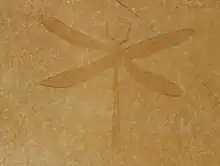| Steleopteron Temporal range: | |
|---|---|
 | |
| Steleopteron cretacicus | |
| Scientific classification | |
| Domain: | Eukaryota |
| Kingdom: | Animalia |
| Phylum: | Arthropoda |
| Class: | Insecta |
| Order: | Odonata |
| Family: | †Steleopteridae |
| Genus: | †Steleopteron Handlirsch, 1906 |
| Species | |
Steleopteon is a genus of extinct winged damselflies whose fossils have been found in modern Germany, and Great Britain, and which lived at the end of the Jurassic and the beginning of the Cretaceous (150.8 to 130 million years ago).[1][2]
The genus was described by the Austrian paleoentomologist Anton Handlirsch in 1906 on the basis of the fossilised exoskeleton Steleopteron deichmuelleri.[3][4] Until 2018, it had been believed that the genus became extinct in the Jurassic, but the discovery of Steleopteron cretacicus showed that the genus and the family may have become extinct as late as the Cretaceous.[5][2] In 2001, Fleck and others transferred the family, Steleopteridae to a suborder of winged damselflies, Zygoptera.[6]
They were fast flying insectivorous/carnivorous predators.[1]
According to the Fossilworks Database website, as of November 2019, the genus includes two extinct species:[1]
- Steleopteron cretacicus Zheng et al. 2018
- Steleopteron deichmuelleri Handlirsch, 1906
References
- 1 2 3 "Steleopteron". fossilworks.org. Retrieved 17 December 2021.
- 1 2 "Steleopteron cretacicus". fossilworks.org. Retrieved 17 December 2021.
- ↑ "Steleopteron deichmuelleri". fossilworks.org. Retrieved 17 December 2021.
- ↑ Handlirsch, A. 1906. Die Fossilen Insekten und die Phylogenie der Rezenten Formen, parts I-IV. Ein Handbuch fur Palaontologen und Zoologen 1-640 p.598
- ↑ Zheng, Daran; Nel, A.; Jarzembowski, E.A. (2018). "The first Cretaceous damselfly of the Jurassic family Steleopteridae (Odonata: Zygoptera), from Surrey, England" (PDF). Cretaceous Research. 93: 1–3. doi:10.1016/j.cretres.2018.08.022. ISSN 0195-6671.
- ↑ Fleck, Günther; Bechly, Günter; Nel, André; Martínez-Delclòs, Xavier (2001). "Revision and phylogenetic affinities of the Jurassic Steleopteridae Handlirsch, 1906 (Odonata: Zygoptera". Insect Systematics & Evolution. 32 (3): 285–305. doi:10.1163/187631201X00227. ISSN 1876-312X. Request pdf
